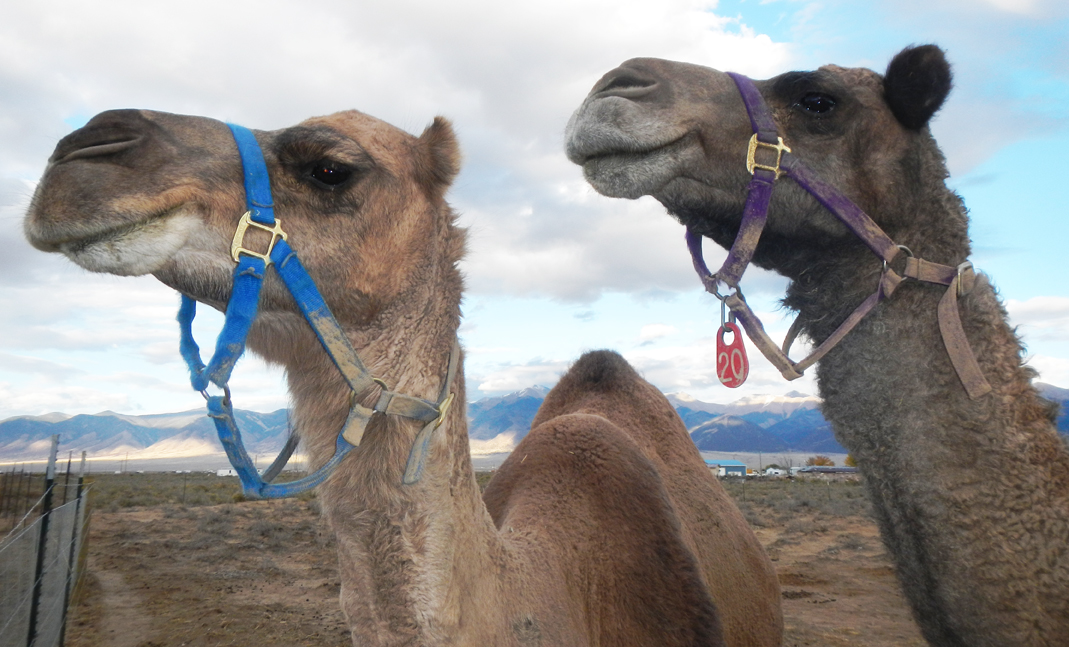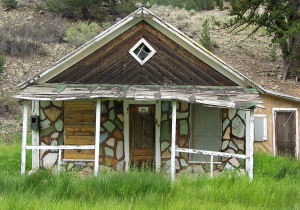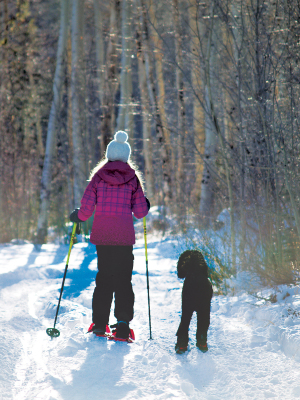By Judith Reese
The late afternoon sun is just beginning to cast long shadows on the San Luis Valley floor. In pastureland renown for sheep and cattle, three vaguely Dr. Seussish fantastical creatures graze on the low brush of the high desert of Moffat. Camels, once thought exotic, now make their home in Colorado’s heartland.
Mudita Camel Dairy, a modest two-story combined home and milking barn, sits framed by the Sangre de Cristo Range to the east and the La Garita Wilderness to the west. Out front, a young couple loads milk into refrigerators in a pickup. They are Matt and Meghan Stalzer, and the camel dairy farm is their labor of love.
Matt moves inside, and nine-foot-tall Dora pokes her head into the barn, her 1,500-pound girth framed by the doorway with the Sangres supplying the backdrop. Inquisitive Dora just wants to be part of the welcoming.

Once outside in the corral, Meghan and Matt share their story. “It’s always been our goal to have a homestead,” says Meghan, affectionately petting 1,600-pound Big Mama, mother of yearling Niam. Meghan wears her simple cowgirl hat fashioned from Dora’s wool. She notes that Big Mama and Dora are African camels while Niam, whose name means “brilliance of color” in Gaelic, is half painted camel, a breed from the Canary Islands. His down is a deep chocolate, in contrast to the traditional fawn color of the two females.
Brushing Dora, husband Matt, who single-handedly built their two-story homestead, explains that this is the third year of their “camel project.” “We started pursuing our business three years ago,” he notes. “We toyed with vegetables or buffalo or goats.” Then an article in Grit magazine introduced the two to the camel milk industry. Both quit their jobs and spent a year in training in Michigan, learning to milk and run a herd. Dora meanders over for some attention, moving with the graceful, loping stride characteristic of her species. Matt says that these are smart animals, and if trained properly and loved, they are gentle. “We treat our animals as part of our family,” adds Meghan, noting that Dora came from a game park in Kentucky, while Big Mama and calf Niam came from Tennessee. She believes there are between 3,000 and 4,000 dromedaries, another name for the single-humped camel that makes up their small herd, in the United States.
“We have a valley with similar conditions to the Sinai,” states Matt. “The dry soil is good for the camels. It has fewer parasites.” He adds that the sparse vegetation also keeps the animals from overeating. Meghan points out that their fuzzy ears, eyelids and long lashes, along with their ability to shut their nostrils, are all adaptations that make their Central Colorado farm, with the Great Sand Dunes nearby, a suitable habitat for camels. The animal’s thick skin also protects them from the winds of Moffat’s arid ecosystem.
“Camel milk has been used as a staple food for people for thousands of years, notably in Mongolia and among Bedouin nomads,” explains Meghan. While the two dairy farmers make no claims about the health benefits of camel milk, they do suggest that camel milk is a wholesome food, and testimonials attest to its nutritional properties. Matt remarks, “It’s a cleansing milk that helps the immune system.”
[InContentAdTwo]
This is the dairy’s second year of production. “We have a private membership association,” said Matt. Meghan affirms that the association “allows us to come together as a people and consume a food. We have a choice of what we put in our bodies.” The milk is tested in a Boulder lab and distributed to members, mostly locally in Crestone, Salida, Alamosa and Colorado Springs. “Our milk is fresh,” she insists. “It goes straight to refrigeration.” “We are not certified organic,” Matt admits, “but we feed all organic and don’t use antibiotics or hormones. Eventually we would like to be a sustainable farm. We’re off the grid, but our goal is to be solar.”
Meghan grew up in Massachusetts and Matt is from Chicago. Both have ties to Colorado. “The area is beautiful,” shares Meghan. “This is perfect. It’s flat and has amazing views, and our camels need a desert.” ‘“Mudita” is Sanskrit for “Our happiness comes from your happiness,’” Meghan explains. “The name symbolizes what we want to do: help people, inspire.”
The dairy is a two-person endeavor, but the couple hopes to expand. “We milk seven days a week, so we never sleep in,” grins Matt. “We hope to help the economy here. We should have two more people helping us.” Meghan adds, “We would like to have a herd of ten: four milking camels and four breeders.” She envisions a cooperative with additional employees and a fiber component. Camels do not need shearing, just brushing, as they shed each spring.
Sensing it is time for milking, Big Mama heads for the barn. Dora huddles in close. Currently Big Mama is the only milk producer on the farm, but Dora is expecting any day. Niam has been separated from his mother until milking. The isolation ensures that Big Mama will produce up to 12 pints of milk. Her year of lactation is coming to an end, and right now she is only producing six or seven pints, explains Meghan. Unlike cattle, camels will not let down their milk unless their calf is present, so Niam joins his mother.
The shadows have deepened on the small homestead in the wide valley, but Matt and Meghan still have chores. Mudita. At work in the milking barn, the two are living their convictions. http://muditacamels.com
Judith Reese lives in Nathrop. While petting Dora, she thought she saw a star rising above Crestone.




What a fun article about an unusual sight: camels in Colorado. GREAT to see Meghan and Matt living out their dreams with such passion and commitment.
Camels are amazing, gentle beasts and their milk is my favorite of all the dairy animals. I have been a member of Matt and Meghan’s assoc. for 5 months and can personally attest to the quality, taste and health benefits of their dairy’s milk. They are wonderful people who care for their animals with love and have a deep repect for the land. It feels good (and tastes great) to support our local camel dairy!
I bought a rose gardenia Big Mama soap made of camel’s milk yesterday and it is completely wonderful! Very much enjoyed reading this story and knowing about these intelligent, brave young people and their fascinating animals. Thank you sincerely.